display BMW ACTIVE HYBRID 3 2014 F30H Owner's Manual
[x] Cancel search | Manufacturer: BMW, Model Year: 2014, Model line: ACTIVE HYBRID 3, Model: BMW ACTIVE HYBRID 3 2014 F30HPages: 247, PDF Size: 6.04 MB
Page 203 of 247

Hood
Hints Working in the engine compartment
Never attempt to perform any service or
repair operations on your vehicle without the
necessary professional technical training.
If you are unfamiliar with the statutory guide‐
lines, have any work on the vehicle performed
only by a service center.
If work is not carried out properly, there is a
danger of subsequent damage and related
safety hazards.◀
Never reach into the engine compart‐
ment
Never reach into spaces or gaps in the engine
compartment; otherwise, there is a risk of in‐
jury, e.g., from rotating or hot parts.◀
Fold down wiper arm
Before opening the hood, ensure that the
wiper arms are against the windshield, or this
may result in damage.◀
Opening the hood1.Pull lever, arrow 1.
Hood is unlocked2.After the lever is released, pull the lever
again, arrow 2.
Hood can be opened.Indicator/warning lights
When the hood is opened, a Check Control
message is displayed.
Closing the hood Hood open when driving
If you see any signs that the hood is not
completely closed while driving, pull over im‐
mediately and close it securely.◀
Danger of jamming
Make sure that the closing path of the
hood is clear; otherwise, injuries may result.◀
Let the hood drop from a height of approx. 16
in/40 cm and push down on it to lock it fully.
The hood must audibly engage on both sides.
Seite 199Engine compartmentMobility199
Online Edition for Part no. 01 40 2 956 725 - X/14
Page 204 of 247
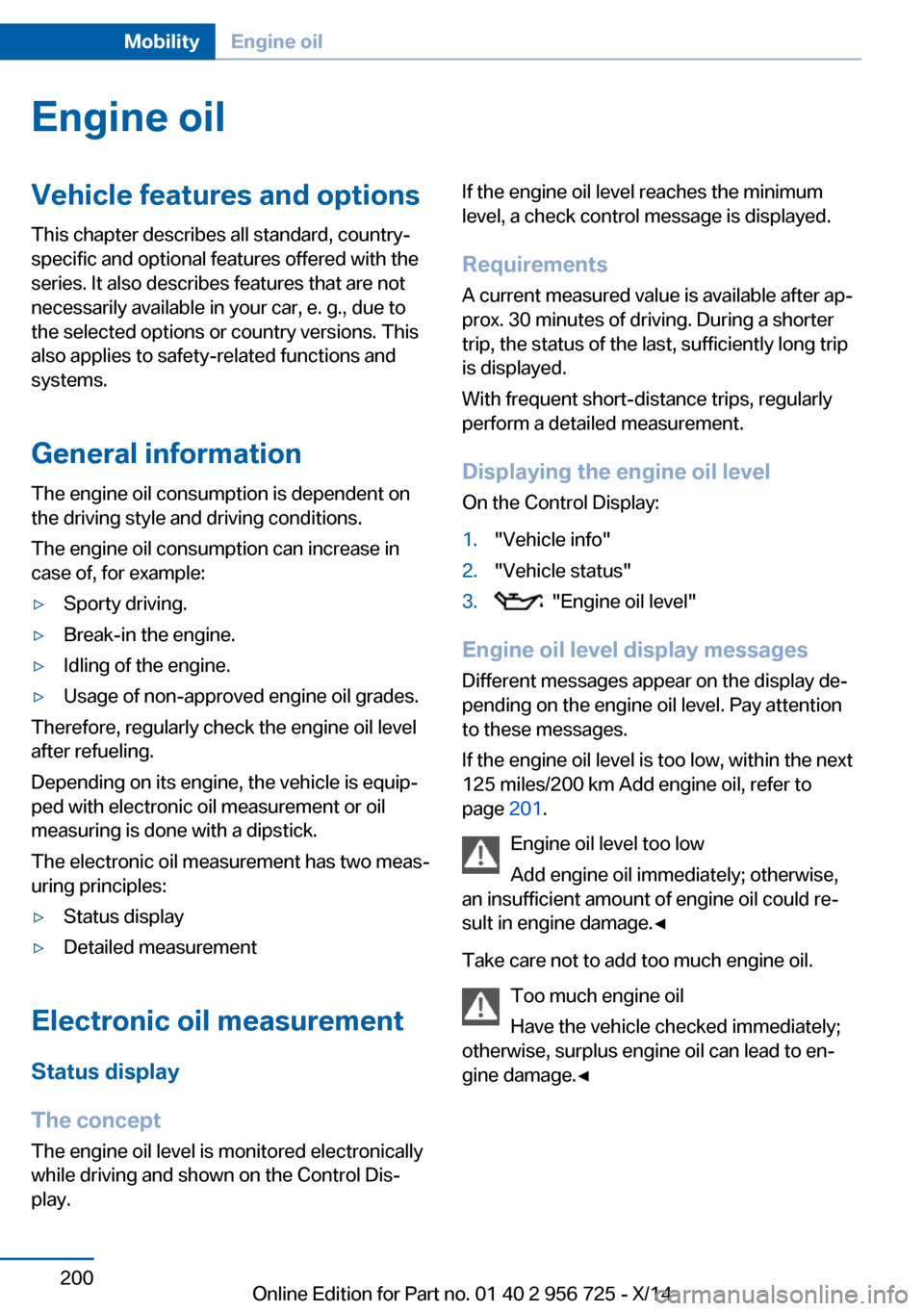
Engine oilVehicle features and options
This chapter describes all standard, country-
specific and optional features offered with the
series. It also describes features that are not
necessarily available in your car, e. g., due to
the selected options or country versions. This
also applies to safety-related functions and
systems.
General information
The engine oil consumption is dependent on
the driving style and driving conditions.
The engine oil consumption can increase in
case of, for example:▷Sporty driving.▷Break-in the engine.▷Idling of the engine.▷Usage of non-approved engine oil grades.
Therefore, regularly check the engine oil level
after refueling.
Depending on its engine, the vehicle is equip‐
ped with electronic oil measurement or oil
measuring is done with a dipstick.
The electronic oil measurement has two meas‐
uring principles:
▷Status display▷Detailed measurement
Electronic oil measurement
Status display
The concept
The engine oil level is monitored electronically
while driving and shown on the Control Dis‐
play.
If the engine oil level reaches the minimum
level, a check control message is displayed.
Requirements
A current measured value is available after ap‐
prox. 30 minutes of driving. During a shorter
trip, the status of the last, sufficiently long trip
is displayed.
With frequent short-distance trips, regularly
perform a detailed measurement.
Displaying the engine oil level
On the Control Display:1."Vehicle info"2."Vehicle status"3. "Engine oil level"
Engine oil level display messages
Different messages appear on the display de‐
pending on the engine oil level. Pay attention
to these messages.
If the engine oil level is too low, within the next
125 miles/200 km Add engine oil, refer to
page 201.
Engine oil level too low
Add engine oil immediately; otherwise,
an insufficient amount of engine oil could re‐
sult in engine damage.◀
Take care not to add too much engine oil. Too much engine oil
Have the vehicle checked immediately;
otherwise, surplus engine oil can lead to en‐
gine damage.◀
Seite 200MobilityEngine oil200
Online Edition for Part no. 01 40 2 956 725 - X/14
Page 205 of 247
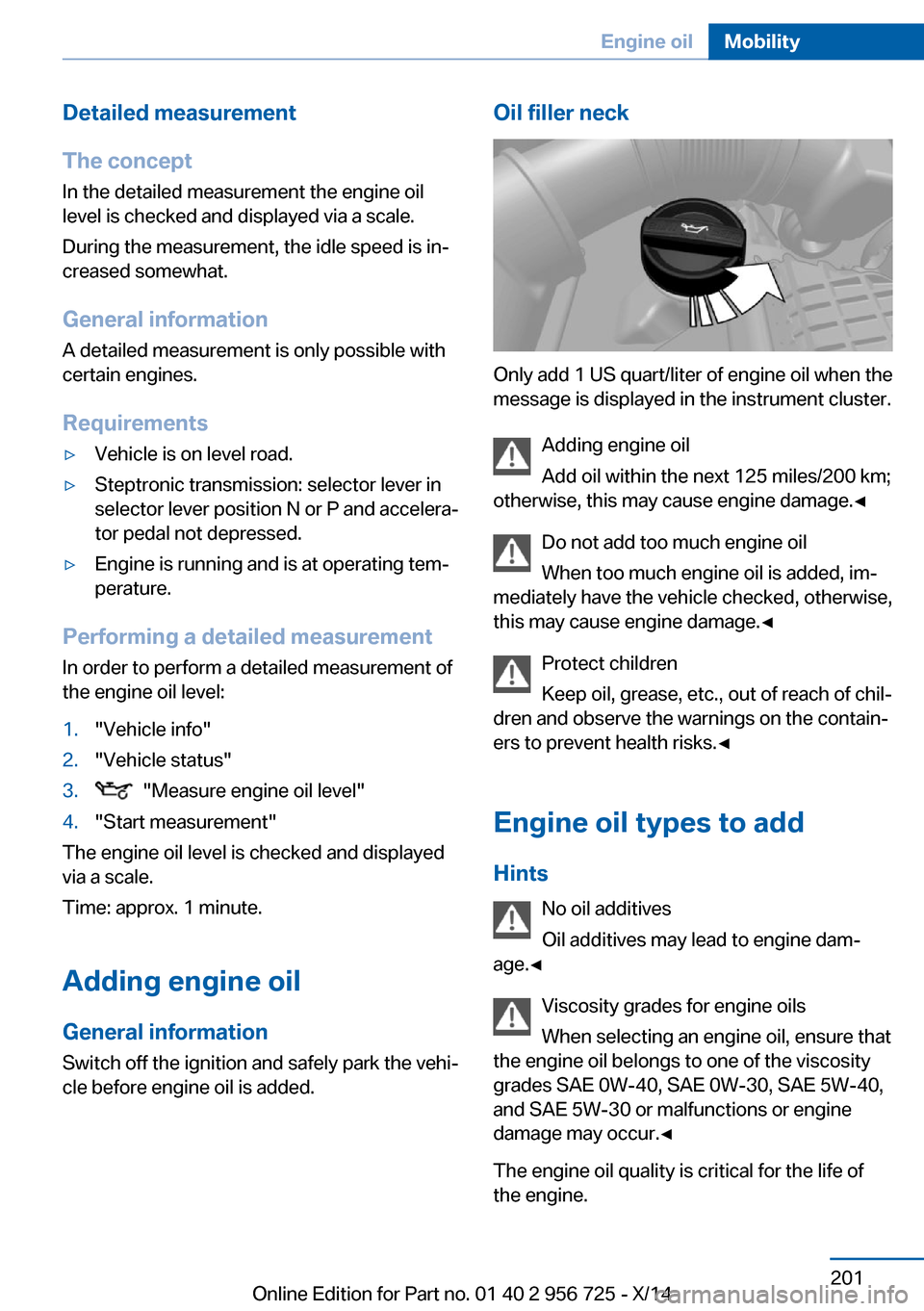
Detailed measurement
The concept In the detailed measurement the engine oil
level is checked and displayed via a scale.
During the measurement, the idle speed is in‐
creased somewhat.
General information
A detailed measurement is only possible with
certain engines.
Requirements▷Vehicle is on level road.▷Steptronic transmission: selector lever in
selector lever position N or P and accelera‐
tor pedal not depressed.▷Engine is running and is at operating tem‐
perature.
Performing a detailed measurement
In order to perform a detailed measurement of
the engine oil level:
1."Vehicle info"2."Vehicle status"3. "Measure engine oil level"4."Start measurement"
The engine oil level is checked and displayed
via a scale.
Time: approx. 1 minute.
Adding engine oil General information
Switch off the ignition and safely park the vehi‐
cle before engine oil is added.
Oil filler neck
Only add 1 US quart/liter of engine oil when the
message is displayed in the instrument cluster.
Adding engine oil
Add oil within the next 125 miles/200 km;
otherwise, this may cause engine damage.◀
Do not add too much engine oil
When too much engine oil is added, im‐
mediately have the vehicle checked, otherwise,
this may cause engine damage.◀
Protect children
Keep oil, grease, etc., out of reach of chil‐
dren and observe the warnings on the contain‐
ers to prevent health risks.◀
Engine oil types to add Hints No oil additives
Oil additives may lead to engine dam‐
age.◀
Viscosity grades for engine oils
When selecting an engine oil, ensure that
the engine oil belongs to one of the viscosity
grades SAE 0W-40, SAE 0W-30, SAE 5W-40,
and SAE 5W-30 or malfunctions or engine
damage may occur.◀
The engine oil quality is critical for the life of
the engine.
Seite 201Engine oilMobility201
Online Edition for Part no. 01 40 2 956 725 - X/14
Page 208 of 247
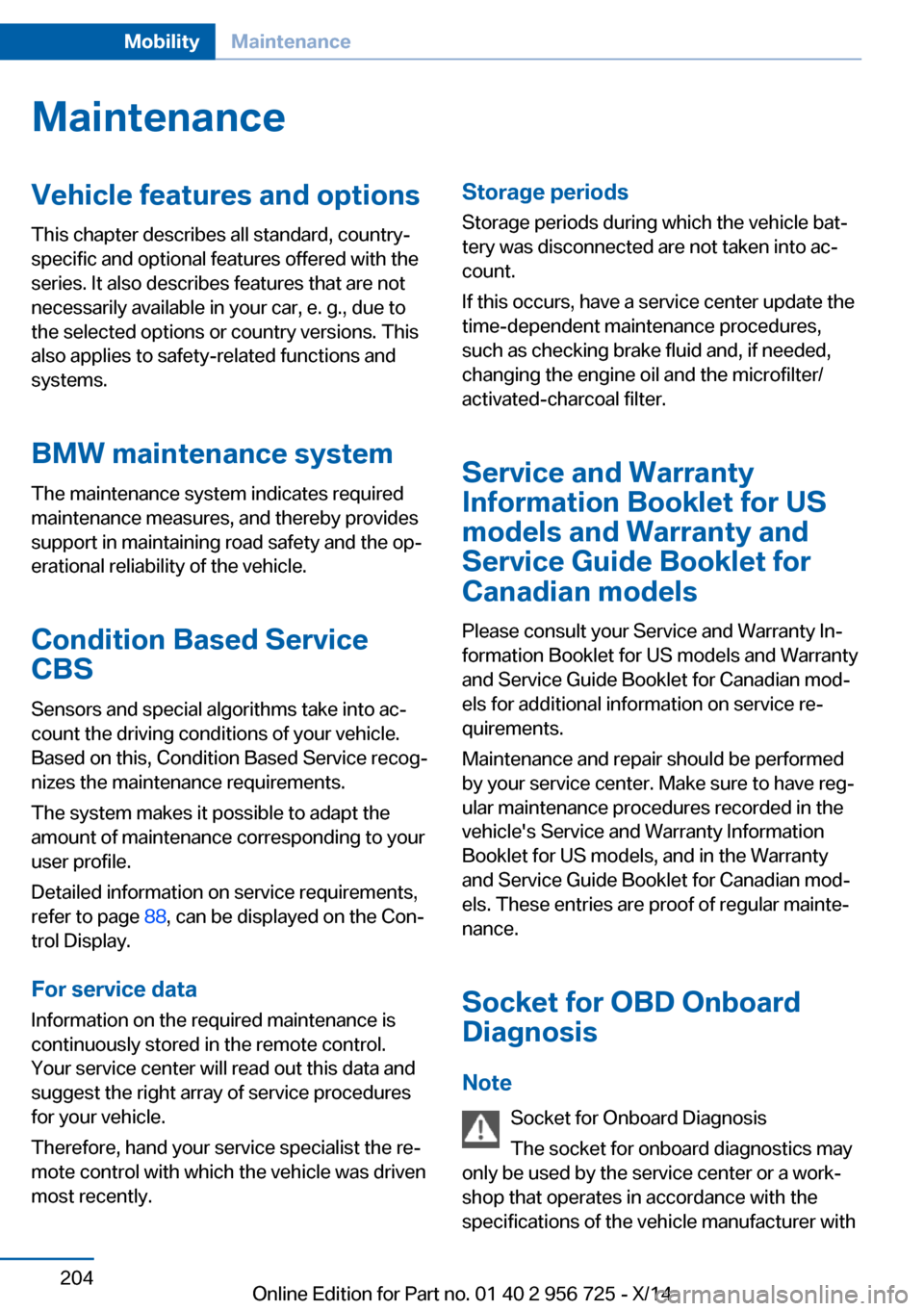
MaintenanceVehicle features and options
This chapter describes all standard, country-
specific and optional features offered with the
series. It also describes features that are not
necessarily available in your car, e. g., due to
the selected options or country versions. This
also applies to safety-related functions and
systems.
BMW maintenance system
The maintenance system indicates required
maintenance measures, and thereby provides
support in maintaining road safety and the op‐
erational reliability of the vehicle.
Condition Based Service
CBS
Sensors and special algorithms take into ac‐
count the driving conditions of your vehicle.
Based on this, Condition Based Service recog‐
nizes the maintenance requirements.
The system makes it possible to adapt the
amount of maintenance corresponding to your
user profile.
Detailed information on service requirements,
refer to page 88, can be displayed on the Con‐
trol Display.
For service data
Information on the required maintenance is
continuously stored in the remote control. Your service center will read out this data and
suggest the right array of service procedures for your vehicle.
Therefore, hand your service specialist the re‐
mote control with which the vehicle was driven
most recently.Storage periods
Storage periods during which the vehicle bat‐
tery was disconnected are not taken into ac‐
count.
If this occurs, have a service center update the
time-dependent maintenance procedures,
such as checking brake fluid and, if needed,
changing the engine oil and the microfilter/
activated-charcoal filter.
Service and Warranty
Information Booklet for US
models and Warranty and
Service Guide Booklet for
Canadian models
Please consult your Service and Warranty In‐
formation Booklet for US models and Warranty
and Service Guide Booklet for Canadian mod‐ els for additional information on service re‐
quirements.
Maintenance and repair should be performed
by your service center. Make sure to have reg‐
ular maintenance procedures recorded in the
vehicle's Service and Warranty Information
Booklet for US models, and in the Warranty
and Service Guide Booklet for Canadian mod‐
els. These entries are proof of regular mainte‐
nance.
Socket for OBD Onboard
Diagnosis
Note Socket for Onboard Diagnosis
The socket for onboard diagnostics may
only be used by the service center or a work‐
shop that operates in accordance with the
specifications of the vehicle manufacturer withSeite 204MobilityMaintenance204
Online Edition for Part no. 01 40 2 956 725 - X/14
Page 219 of 247
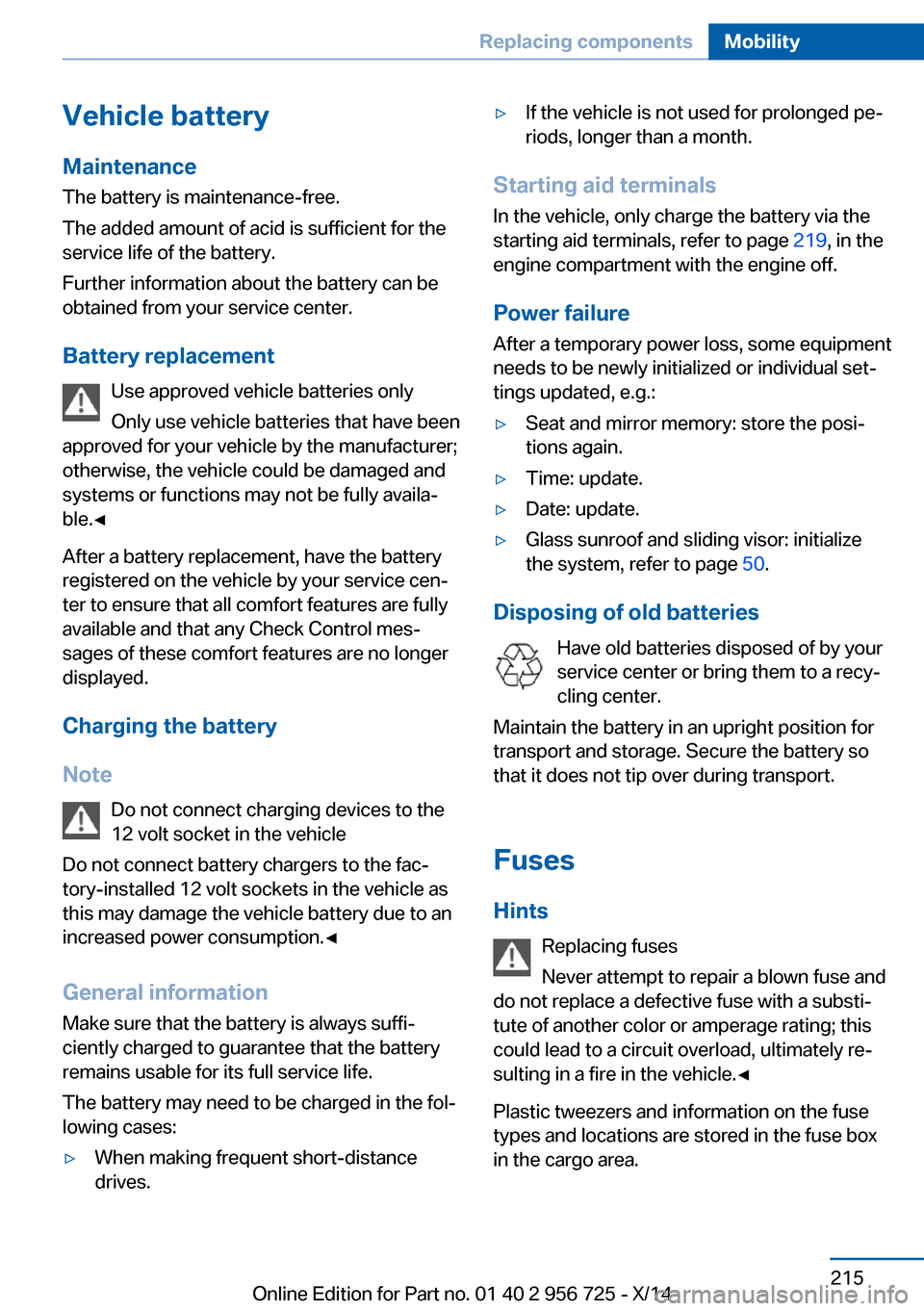
Vehicle batteryMaintenance
The battery is maintenance-free.
The added amount of acid is sufficient for the
service life of the battery.
Further information about the battery can be
obtained from your service center.
Battery replacement Use approved vehicle batteries only
Only use vehicle batteries that have been
approved for your vehicle by the manufacturer;
otherwise, the vehicle could be damaged and
systems or functions may not be fully availa‐
ble.◀
After a battery replacement, have the battery
registered on the vehicle by your service cen‐
ter to ensure that all comfort features are fully
available and that any Check Control mes‐
sages of these comfort features are no longer
displayed.
Charging the battery
Note Do not connect charging devices to the12 volt socket in the vehicle
Do not connect battery chargers to the fac‐
tory-installed 12 volt sockets in the vehicle as
this may damage the vehicle battery due to an
increased power consumption.◀
General information Make sure that the battery is always suffi‐
ciently charged to guarantee that the battery
remains usable for its full service life.
The battery may need to be charged in the fol‐
lowing cases:▷When making frequent short-distance
drives.▷If the vehicle is not used for prolonged pe‐
riods, longer than a month.
Starting aid terminals
In the vehicle, only charge the battery via the
starting aid terminals, refer to page 219, in the
engine compartment with the engine off.
Power failure After a temporary power loss, some equipment
needs to be newly initialized or individual set‐
tings updated, e.g.:
▷Seat and mirror memory: store the posi‐
tions again.▷Time: update.▷Date: update.▷Glass sunroof and sliding visor: initialize
the system, refer to page 50.
Disposing of old batteries
Have old batteries disposed of by your
service center or bring them to a recy‐
cling center.
Maintain the battery in an upright position for
transport and storage. Secure the battery so
that it does not tip over during transport.
Fuses Hints Replacing fuses
Never attempt to repair a blown fuse and
do not replace a defective fuse with a substi‐
tute of another color or amperage rating; this
could lead to a circuit overload, ultimately re‐
sulting in a fire in the vehicle.◀
Plastic tweezers and information on the fuse
types and locations are stored in the fuse box
in the cargo area.
Seite 215Replacing componentsMobility215
Online Edition for Part no. 01 40 2 956 725 - X/14
Page 221 of 247
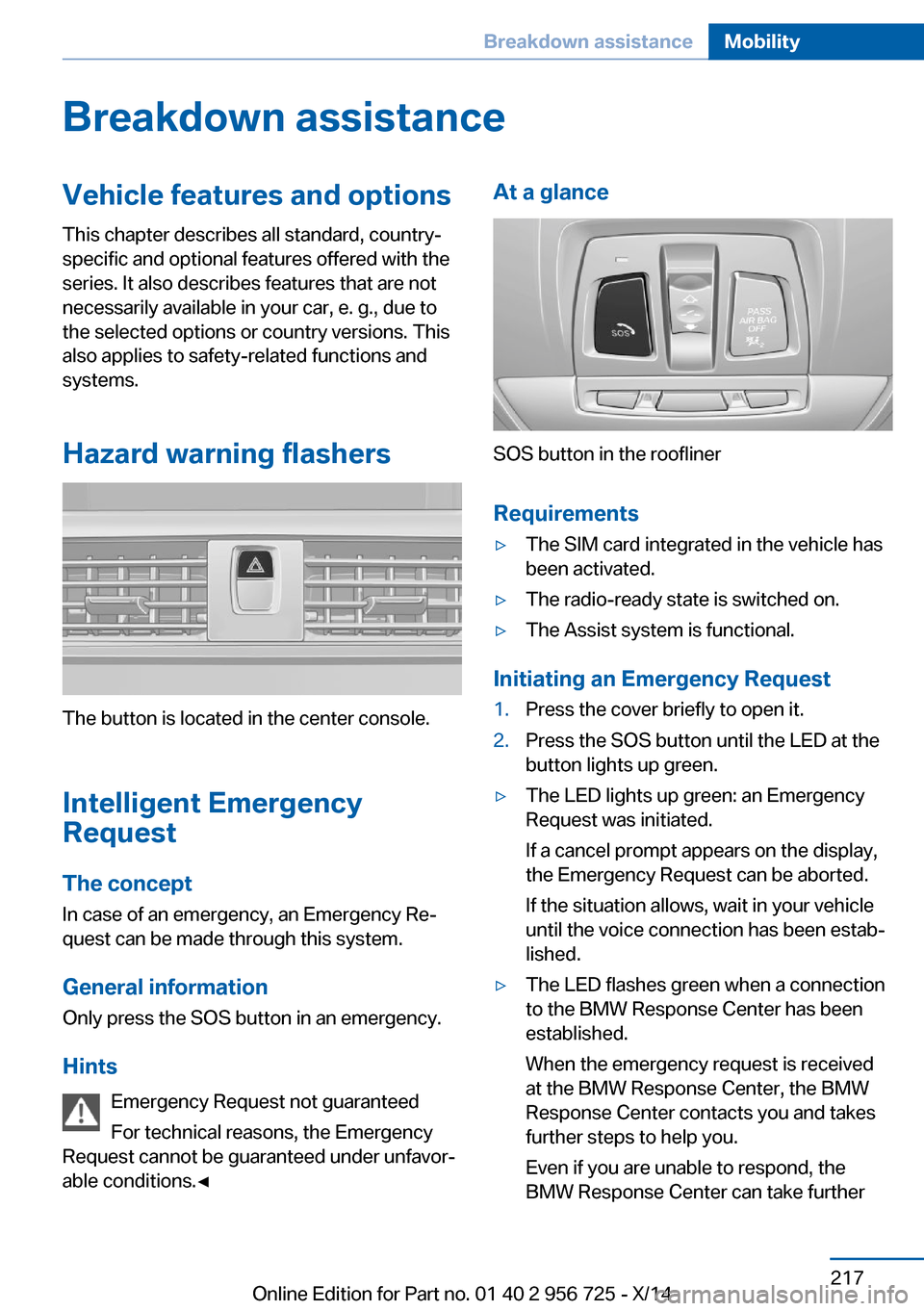
Breakdown assistanceVehicle features and options
This chapter describes all standard, country-
specific and optional features offered with the
series. It also describes features that are not
necessarily available in your car, e. g., due to
the selected options or country versions. This
also applies to safety-related functions and
systems.
Hazard warning flashers
The button is located in the center console.
Intelligent Emergency
Request
The concept In case of an emergency, an Emergency Re‐
quest can be made through this system.
General information
Only press the SOS button in an emergency.
Hints Emergency Request not guaranteed
For technical reasons, the Emergency
Request cannot be guaranteed under unfavor‐
able conditions.◀
At a glance
SOS button in the roofliner
Requirements
▷The SIM card integrated in the vehicle has
been activated.▷The radio-ready state is switched on.▷The Assist system is functional.
Initiating an Emergency Request
1.Press the cover briefly to open it.2.Press the SOS button until the LED at the
button lights up green.▷The LED lights up green: an Emergency
Request was initiated.
If a cancel prompt appears on the display,
the Emergency Request can be aborted.
If the situation allows, wait in your vehicle
until the voice connection has been estab‐
lished.▷The LED flashes green when a connection
to the BMW Response Center has been
established.
When the emergency request is received
at the BMW Response Center, the BMW
Response Center contacts you and takes
further steps to help you.
Even if you are unable to respond, the
BMW Response Center can take furtherSeite 217Breakdown assistanceMobility217
Online Edition for Part no. 01 40 2 956 725 - X/14
Page 230 of 247

Carpets and floor matsNo objects in the area around the pedals
Keep floor mats, carpets, and any other
objects out of the pedal area; otherwise, the
function of the pedals could be impeded while driving and create the risk of an accident.
Do not place additional floor mats over existing
mats or other objects.
Only use floor mats that have been approved
for the vehicle and can be properly attached to
floor.
Ensure that the floor mats are securely fas‐
tened again after they were removed for clean‐
ing, e.g.◀
Floor mats can be removed from the car's inte‐
rior for cleaning.
If the floor carpets are very dirty, clean with a microfiber cloth and water or a textile cleaner.
To prevent matting of the carpet, rub back and
forth in the direction of travel only.
Sensors/cameras
To clean sensors and cameras, use a cloth
moistened with a small amount of glass
cleaner.
Displays/monitors Cleaning displays and screens
Do not use any chemical or household
cleaning agents; otherwise, surfaces can be af‐
fected.◀
Keeping out moisture
Keep all fluids and moisture away from
the unit; otherwise, electrical components can
be damaged.◀
Avoid pressure
Avoid pressing too hard when cleaning
and do not use abrasive materials; otherwise,
damage can result.◀
Clean with a clean, antistatic microfiber cloth.Long-term For idle phases that last several weeks, park
the vehicle with a fully charged battery if possi‐
ble. Your service center can advise you on
what to consider when storing the vehicle for
longer than six weeks.
Do not allow the vehicle to sit idle for ex‐
tended periods with a low charging state
Before storing the vehicle for an extended pe‐
riod, check the battery charge indicator to en‐
sure that the high-voltage battery is fully
charged. If necessary, charge the high-voltage
battery by driving the vehicle. Check the
charge level regularly, and if needed recharge
the high-voltage battery by driving the vehicle.
Don't allow battery charge status to drop too
low - it will damage the battery.◀
Note Follow the instructions for discharging thehigh-voltage battery, refer to page 171.Seite 226MobilityCare226
Online Edition for Part no. 01 40 2 956 725 - X/14
Page 236 of 247

Everything from A to Z
IndexA ABS, Antilock Brake Sys‐ tem 124
ACC, Active Cruise Control with Stop & Go 129
Acceleration Assistant, refer to Launch Control 78
Activated-charcoal filter 153
Activate drive readiness 68
Active Blind Spot Detec‐ tion 120
Active Cruise Control with Stop & Go, ACC 129
ActiveHybrid, system 31
Adapting to the course of the road, hybrid system 83
Adaptive brake lights, refer to Brake force display 122
Adaptive Light Control 98
Additives, oil 201
Adjustments, seats/head re‐ straints 52
After washing vehicle 224
Airbags 102
Airbags, indicator/warning light 103
Air circulation, refer to Recir‐ culated-air mode 152
Air, dehumidifying, refer to Cooling function 151
Air distribution, manual 152
Air flow, automatic climate control 152
Air pressure, tires 190
Air vents, refer to Ventila‐ tion 153
Alarm system 46
Alarm, unintentional 47
All around the center con‐ sole 16 All around the roofliner 17
All around the steering wheel 14
All-season tires, refer to Win‐ ter tires 196
Alternating-code hand-held transmitter 157
Alternative oil types 202
Antifreeze, washer fluid 75
Antilock Brake System, ABS 124
Anti-slip control, refer to DSC 124
Approved axle load 231
Approved engine oils 202
Arrival time 92
Ash tray 160
Assistance for the combus‐ tion engine, ASSIST 71
Assistance for the combus‐ tion engine, eBOOST 71
Assistance, Roadside Assis‐ tance 218
Assistance when driving off 128
ASSIST, assistance for the combustion engine 71
Assist system information, on Control Display 95
Attentiveness assistant 122
AUTO intensity 151
Automatic car wash 223
Automatic climate control with enhanced features 150
Automatic Cruise Control with Stop & Go 129
Automatic Curb Monitor 60
Automatic deactivation, front- seat passenger airbags 104
Automatic deactivation of the hybrid system 222 Automatic engine start-stop
function 69
Automatic headlight con‐ trol 98
Automatic locking 45
Automatic recirculated-air control 152
Automatic transmission, see Steptronic transmission 76
AUTO program, automatic cli‐ mate control 151
AUTO program, intensity 151
Auxiliary air conditioning 154
Average fuel consumption 92
Average speed 92
Axle loads, weights 231
B Backrest curvature, refer to Lumbar support 54
Backrest, width 54
Band-aids, refer to First aid kit 218
Bar for tow-starting/ towing 220
Battery replacement, vehicle battery 215
Battery replacement, vehicle remote control 37
Battery, vehicle 215
Belts, safety belts 55
Beverage holder, cu‐ pholder 166
Blinds, sun protection 49
BMW ActiveHybrid 31
BMW Assist, see user's manual for Navigation, En‐
tertainment and Communi‐
cation Seite 232ReferenceEverything from A to Z232
Online Edition for Part no. 01 40 2 956 725 - X/14
Page 237 of 247
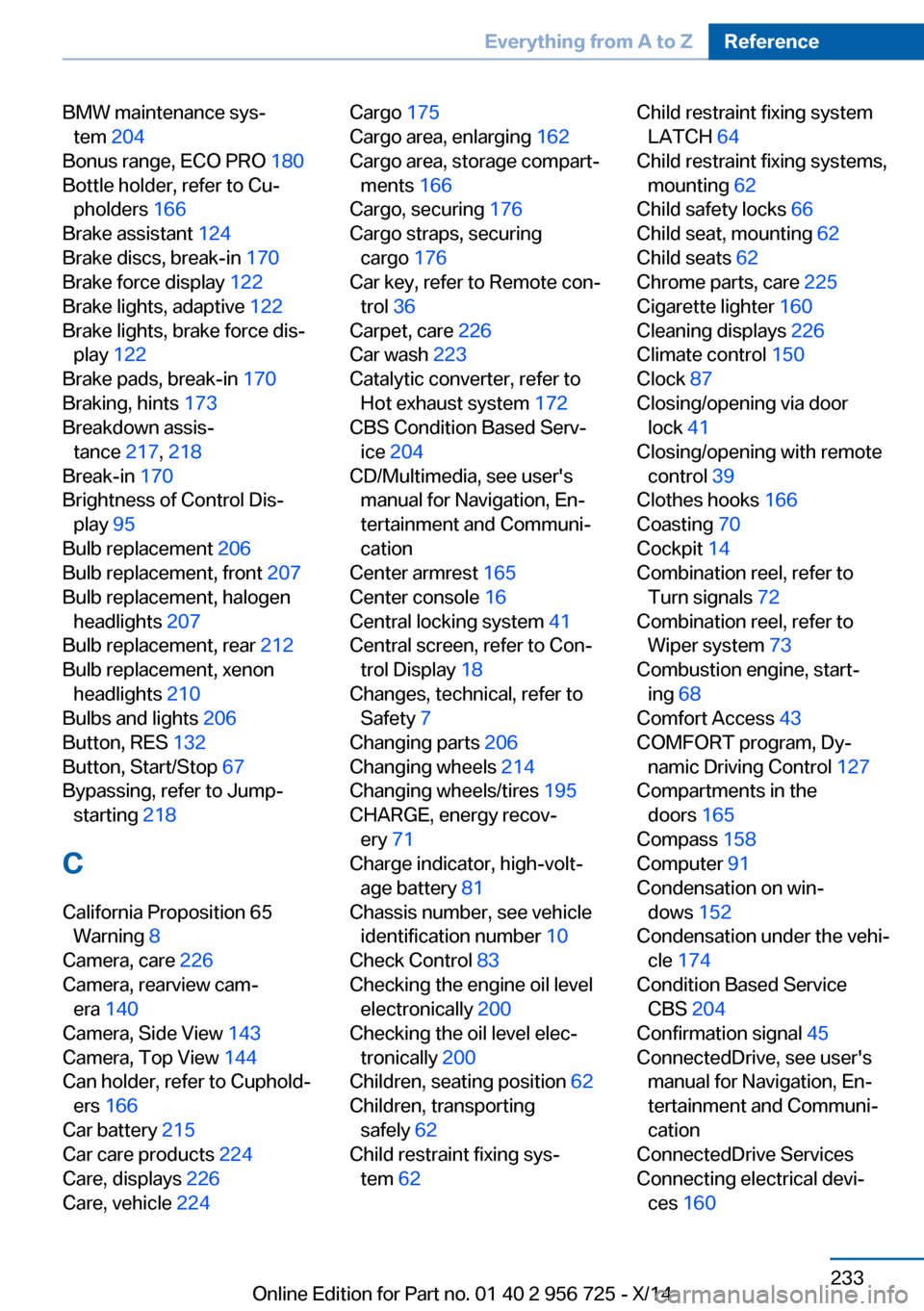
BMW maintenance sys‐tem 204
Bonus range, ECO PRO 180
Bottle holder, refer to Cu‐ pholders 166
Brake assistant 124
Brake discs, break-in 170
Brake force display 122
Brake lights, adaptive 122
Brake lights, brake force dis‐ play 122
Brake pads, break-in 170
Braking, hints 173
Breakdown assis‐ tance 217, 218
Break-in 170
Brightness of Control Dis‐ play 95
Bulb replacement 206
Bulb replacement, front 207
Bulb replacement, halogen headlights 207
Bulb replacement, rear 212
Bulb replacement, xenon headlights 210
Bulbs and lights 206
Button, RES 132
Button, Start/Stop 67
Bypassing, refer to Jump- starting 218
C
California Proposition 65 Warning 8
Camera, care 226
Camera, rearview cam‐ era 140
Camera, Side View 143
Camera, Top View 144
Can holder, refer to Cuphold‐ ers 166
Car battery 215
Car care products 224
Care, displays 226
Care, vehicle 224 Cargo 175
Cargo area, enlarging 162
Cargo area, storage compart‐ ments 166
Cargo, securing 176
Cargo straps, securing cargo 176
Car key, refer to Remote con‐ trol 36
Carpet, care 226
Car wash 223
Catalytic converter, refer to Hot exhaust system 172
CBS Condition Based Serv‐ ice 204
CD/Multimedia, see user's manual for Navigation, En‐
tertainment and Communi‐
cation
Center armrest 165
Center console 16
Central locking system 41
Central screen, refer to Con‐ trol Display 18
Changes, technical, refer to Safety 7
Changing parts 206
Changing wheels 214
Changing wheels/tires 195
CHARGE, energy recov‐ ery 71
Charge indicator, high-volt‐ age battery 81
Chassis number, see vehicle identification number 10
Check Control 83
Checking the engine oil level electronically 200
Checking the oil level elec‐ tronically 200
Children, seating position 62
Children, transporting safely 62
Child restraint fixing sys‐ tem 62 Child restraint fixing system
LATCH 64
Child restraint fixing systems, mounting 62
Child safety locks 66
Child seat, mounting 62
Child seats 62
Chrome parts, care 225
Cigarette lighter 160
Cleaning displays 226
Climate control 150
Clock 87
Closing/opening via door lock 41
Closing/opening with remote control 39
Clothes hooks 166
Coasting 70
Cockpit 14
Combination reel, refer to Turn signals 72
Combination reel, refer to Wiper system 73
Combustion engine, start‐ ing 68
Comfort Access 43
COMFORT program, Dy‐ namic Driving Control 127
Compartments in the doors 165
Compass 158
Computer 91
Condensation on win‐ dows 152
Condensation under the vehi‐ cle 174
Condition Based Service CBS 204
Confirmation signal 45
ConnectedDrive, see user's manual for Navigation, En‐
tertainment and Communi‐
cation
ConnectedDrive Services
Connecting electrical devi‐ ces 160 Seite 233Everything from A to ZReference233
Online Edition for Part no. 01 40 2 956 725 - X/14
Page 238 of 247
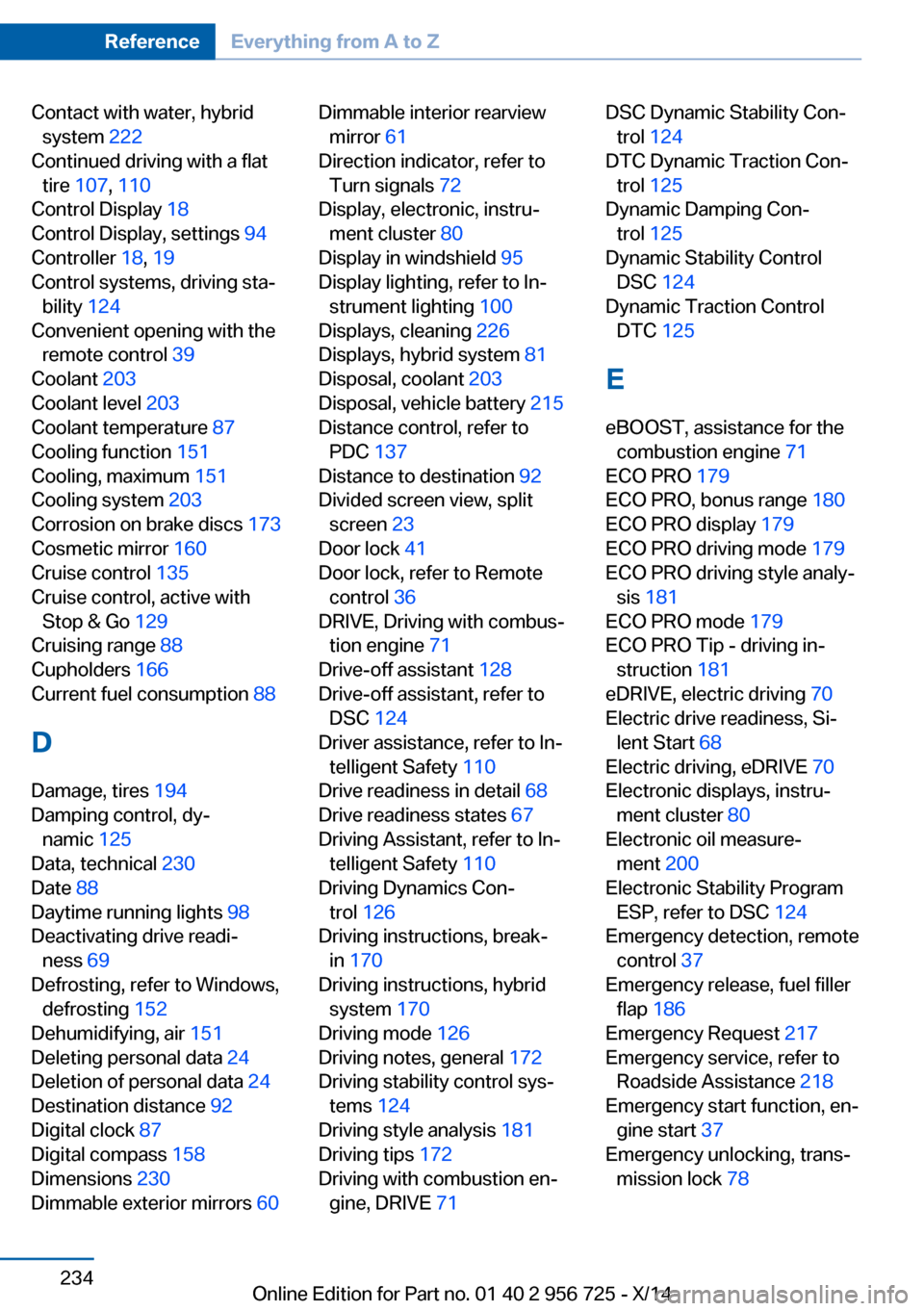
Contact with water, hybridsystem 222
Continued driving with a flat tire 107 , 110
Control Display 18
Control Display, settings 94
Controller 18, 19
Control systems, driving sta‐ bility 124
Convenient opening with the remote control 39
Coolant 203
Coolant level 203
Coolant temperature 87
Cooling function 151
Cooling, maximum 151
Cooling system 203
Corrosion on brake discs 173
Cosmetic mirror 160
Cruise control 135
Cruise control, active with Stop & Go 129
Cruising range 88
Cupholders 166
Current fuel consumption 88
D
Damage, tires 194
Damping control, dy‐ namic 125
Data, technical 230
Date 88
Daytime running lights 98
Deactivating drive readi‐ ness 69
Defrosting, refer to Windows, defrosting 152
Dehumidifying, air 151
Deleting personal data 24
Deletion of personal data 24
Destination distance 92
Digital clock 87
Digital compass 158
Dimensions 230
Dimmable exterior mirrors 60 Dimmable interior rearview
mirror 61
Direction indicator, refer to Turn signals 72
Display, electronic, instru‐ ment cluster 80
Display in windshield 95
Display lighting, refer to In‐ strument lighting 100
Displays, cleaning 226
Displays, hybrid system 81
Disposal, coolant 203
Disposal, vehicle battery 215
Distance control, refer to PDC 137
Distance to destination 92
Divided screen view, split screen 23
Door lock 41
Door lock, refer to Remote control 36
DRIVE, Driving with combus‐ tion engine 71
Drive-off assistant 128
Drive-off assistant, refer to DSC 124
Driver assistance, refer to In‐ telligent Safety 110
Drive readiness in detail 68
Drive readiness states 67
Driving Assistant, refer to In‐ telligent Safety 110
Driving Dynamics Con‐ trol 126
Driving instructions, break- in 170
Driving instructions, hybrid system 170
Driving mode 126
Driving notes, general 172
Driving stability control sys‐ tems 124
Driving style analysis 181
Driving tips 172
Driving with combustion en‐ gine, DRIVE 71 DSC Dynamic Stability Con‐
trol 124
DTC Dynamic Traction Con‐ trol 125
Dynamic Damping Con‐ trol 125
Dynamic Stability Control DSC 124
Dynamic Traction Control DTC 125
E eBOOST, assistance for the combustion engine 71
ECO PRO 179
ECO PRO, bonus range 180
ECO PRO display 179
ECO PRO driving mode 179
ECO PRO driving style analy‐ sis 181
ECO PRO mode 179
ECO PRO Tip - driving in‐ struction 181
eDRIVE, electric driving 70
Electric drive readiness, Si‐ lent Start 68
Electric driving, eDRIVE 70
Electronic displays, instru‐ ment cluster 80
Electronic oil measure‐ ment 200
Electronic Stability Program ESP, refer to DSC 124
Emergency detection, remote control 37
Emergency release, fuel filler flap 186
Emergency Request 217
Emergency service, refer to Roadside Assistance 218
Emergency start function, en‐ gine start 37
Emergency unlocking, trans‐ mission lock 78 Seite 234ReferenceEverything from A to Z234
Online Edition for Part no. 01 40 2 956 725 - X/14